Advertisements
Chapters
2: Rational Numbers
3: Fractions (Including Problems)
4: Decimal Fractions (Decimals)
5: Exponents (Including Laws of Exponents)
6: Ratio and Proportion (Including Sharing in a Ratio)
7: Unitary Method (Including Time and Work)
8: Percent and Percentage
9: Profit, Loss and Discount
10: Simple Interest
11: Fundamental Concepts (Including Fundamental Operations)
12: Simple Linear Equations (Including Word Problems)
13: Set Concepts (Some Simple Divisions by Vedic Method)
▶ 14: Lines and Angles (Including Construction of angles)
15: Triangles
16: Pythagoras Theorem
17: Symmetry (Including Reflection and Rotation)
18: Recognition of Solids (Representing 3-D in 2-D)
19: Congruency: Congruent Triangles
20: Mensuration
21: Data Handling
22: Probability
![Selina solutions for Concise Mathematics [English] Class 7 ICSE chapter 14 - Lines and Angles (Including Construction of angles) Selina solutions for Concise Mathematics [English] Class 7 ICSE chapter 14 - Lines and Angles (Including Construction of angles) - Shaalaa.com](/images/concise-mathematics-english-class-7-icse_6:880cdcd6265b4864b6486afbf92875b0.jpg)
Advertisements
Solutions for Chapter 14: Lines and Angles (Including Construction of angles)
Below listed, you can find solutions for Chapter 14 of CISCE Selina for Concise Mathematics [English] Class 7 ICSE.
Selina solutions for Concise Mathematics [English] Class 7 ICSE 14 Lines and Angles (Including Construction of angles) Exercise 14 (A)
State, true or false:
A line segment 4 cm long can have only 2000 points in it.
True
False
State, true or false:
A ray has one endpoint and a line segment has two end-points.
True
False
State, true or false:
A line segment is the shortest distance between any two given points.
True
False
State, true or false:
An infinite number of straight lines can be drawn through a given point.
True
False
Write the number of endpoints in
(a) a line segment AB
(b) a ray AB
(c) a line AB
out of \[\overleftrightarrow{AB},\overrightarrow{AB},\overleftarrow{AB}\] and `overline(AB)` which one has a fixed length?
How many rays can be drawn through a fixed point O?
How many lines can be drawn through three
(a) collinear points?
(b) non-collinear points?
State, true or false:
Is 40° the complement of 60°?
True
False
State, true or false:
Is 45° the supplement of 45°?
True
False
In the following figure, ∠AOB and ∠AOC are adjacent angles? Give the reason for your answer.
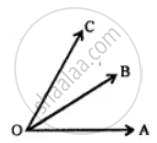
In the following figure, ∠AOB and ∠AOC are adjacent angles? Give the reason for your answer.
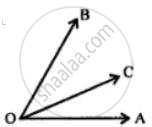
In the following figure, ∠AOB and ∠AOC are adjacent angles? Give the reason for your answer.
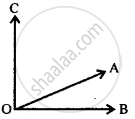
In the following figure, ∠AOB and ∠AOC are adjacent angles? Give the reason for your answer.
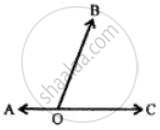
In the given figure, BAC is a straight line.
Find:
(i) x
(ii) ∠AOB
(iii) ∠BOC

Find y in the given figure.

In the given figure, find ∠PQR.

In the given figure. p° = q° = r°, find each.

In the given figure, if x = 2y, find x and y

In the adjoining figure, if b° = a° + c°, find b.
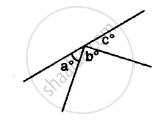
In the given figure, AB is perpendicular to BC at B.
Find:
(i) the value of x.
(ii) the complement of angle x.
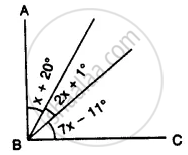
Write the complement of 25°
Write the complement of 90°
Write the complement of a°
Write the complement of (x + 5)°
Write the complement of (30 − a)°
Write the complement of `1/2` of a right angle
Write the complement of `1/3` of 180°
Write the complement of 21° 17'
Write the supplement of 100°
Write the supplement of 0°
Write the supplement of x°
Write the supplement of (x + 35)°
Write the supplement of (90 + a + b)°
Write the supplement of (110 – x – 2y)°
Write the supplement of `1/5` of a right angle
Write the supplement of 80° 49′ 25″
Are the following pairs of angles complementary?
10° and 80°
Are the following pairs of angles complementary?
37° 28′ and 52° 33′
Are the following pairs of angles complementary?
(x + 16)° and (74 − x)°
Are the following pairs of angles complementary?
54° and `2/5` of a right angle.
Are the following pairs of angles supplementary?
139° and 39°.
Are the following pairs of angles supplementary?
26° 59′ and 153° 1′.
Are the following pairs of angles supplementary?
`3/10` of a right angle and `4/15` of two right angles.
Are the following pairs of angles supplementary?
2x° + 65° and 115°− 2x°
If 3x + 18° and 2x + 25° are supplementary, find the value of x.
If two complementary angles are in the ratio 1 : 5, find them.
If two supplementary angles are in the ratio 2 : 7, find them.
Three angles which add up to 180° are in the ratio 2 : 3 : 7. Find them.
20% of an angle is the supplement of 60°. Find the angle.
10% of x° is the complement of 40% of 2x°. Find x
Use the adjacent figure, to find angle x and its supplement.

Find K in the given figure.
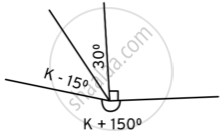
Find k of the given figure.

In the given figure, lines PQ, MN, and RS intersect at O. If x : y = 1 : 2 and z = 90°, find ∠ROM and ∠POR.
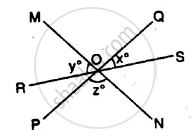
In the given figure, find ∠AOB and ∠BOC.
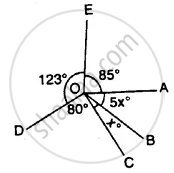
Find each angle shown in the diagram.
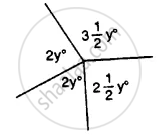
AB, CD and EF are three lines intersecting at the same point.
(i) Find x, if y = 45° and z = 90°.
(ii) Find a, if x = 3a, y = 5x and r = 6x.
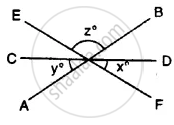
Selina solutions for Concise Mathematics [English] Class 7 ICSE 14 Lines and Angles (Including Construction of angles) Exercise 14 (B)
Identify the given pair of angles as ∠3 and ∠6
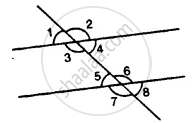
corresponding angles
interior alternate angles
exterior alternate angles
adjacent angles
vertically opposite angles
allied angles
Identify the given pair of angles as ∠2 and ∠4

corresponding angles
interior alternate angles
exterior alternate angles
adjacent angles
vertically opposite angles
allied angles
Identify the given pair of angles as ∠3 and ∠7

corresponding angles
interior alternate angles
exterior alternate angles
adjacent angles
vertically opposite angles
allied angles
Identify the given pair of angles as ∠2 and ∠7

corresponding angles
interior alternate angles
exterior alternate angles
adjacent angles
vertically opposite angles
allied angles
Identify the given pair of angles as ∠4 and ∠6

corresponding angles
interior alternate angles
exterior alternate angles
adjacent angles
vertically opposite angles
allied or co-interior angles
Identify the given pair of angles as ∠1 and ∠8

corresponding angles
interior alternate angles
exterior alternate angles
adjacent angles
vertically opposite angles
allied angles
Identify the given pair of angles as ∠1 and ∠5

corresponding angles
interior alternate angles
exterior alternate angles
adjacent angles
vertically opposite angles
allied angles
Identify the given pair of angles as ∠1 and ∠4

corresponding angles
interior alternate angles
exterior alternate angles
adjacent angles
vertically opposite angles
allied angles
Identify the given pair of angles as ∠5 and ∠7

corresponding angles
interior alternate angles
exterior alternate angles
adjacent angles
vertically opposite angles
allied angles
Identify the given pair of angles as ∠1 and ∠4
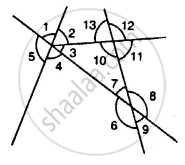
corresponding angles
interior alternate angles
exterior alternate angles
adjacent angles
vertically opposite angles
allied angles
Identify the given pair of angles as ∠4 and ∠7

corresponding angles
interior alternate angles
exterior alternate angles
adjacent angles
vertically opposite angles
allied angles
Identify the given pair of angles as ∠10 and ∠12

corresponding angles
interior alternate angles
exterior alternate angles
adjacent angles
vertically opposite angles
allied angles
Identify the given pair of angles as ∠7 and ∠13
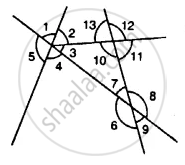
corresponding angles
interior alternate angles
exterior alternate angles
adjacent angles
vertically opposite angles
allied angles
Identify the given pair of angles as ∠6 and ∠8

corresponding angles
interior alternate angles
exterior alternate angles
adjacent angles
vertically opposite angles
allied angles
Identify the given pair of angles as ∠11 and ∠8

corresponding angles
interior alternate angles
exterior alternate angles
adjacent angles
vertically opposite angles
allied or co-interior angles
Identify the given pair of angles as ∠7 and ∠9

corresponding angles
interior alternate angles
exterior alternate angles
adjacent angles
vertically opposite angles
allied angles
Identify the given pair of angles as ∠4 and ∠5
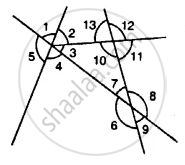
corresponding angles
interior alternate angles
exterior alternate angles
adjacent angles
vertically opposite angles
allied angles
Identify the given pair of angles as ∠4 and ∠6

corresponding angles
interior alternate angles
exterior alternate angles
adjacent angles
vertically opposite angles
allied or co-interior angles
Identify the given pair of angles as ∠6 and ∠7

corresponding angles
interior alternate angles
exterior alternate angles
adjacent angles
vertically opposite angles
allied angles
Identify the given pair of angles as ∠2 and ∠13

corresponding angles
interior alternate angles
exterior alternate angles
adjacent angles
vertically opposite angles
allied or co-interior angles
In the given figure, the arrows indicate parallel lines. State which angles are equal. Give a reason.
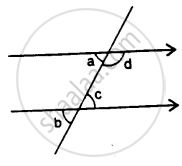
In the given figure, the arrows indicate parallel lines. State which angles are equal. Give a reason.
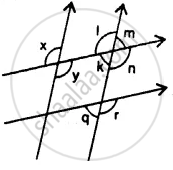
In the given figure, find the measure of the unknown angles:
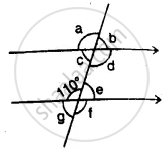
Which pair of the dotted line, segments, in the following figure, are parallel. Give reason:
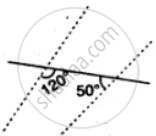
Which pair of the dotted line, segments, in the following figure, are parallel. Give reason:
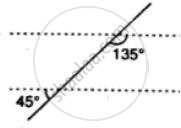
Which pair of the dotted line, segments, in the following figure, are parallel. Give reason:
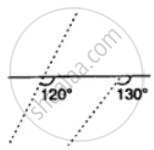
Which pair of the dotted line, segments, in the following figure, are parallel. Give reason:
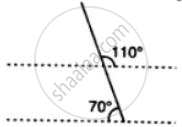
Which pair of the dotted line, segments, in the following figure, are parallel. Give reason:

Which pair of the dotted line, segments, in the following figure, are parallel. Give reason:
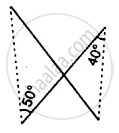
In the given figure, the directed lines are parallel to each other. Find the unknown angles.
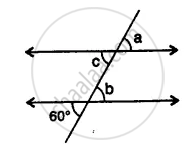
In the given figure, the directed lines are parallel to each other. Find the unknown angles.

In the given figure, the directed lines are parallel to each other. Find the unknown angles.
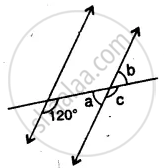
In the given figure, the directed lines are parallel to each other. Find the unknown angles.
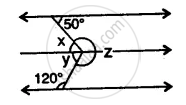
In the given figure, the directed lines are parallel to each other. Find the unknown angles.
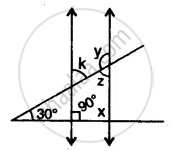
In the given figure, the directed lines are parallel to each other. Find the unknown angles.
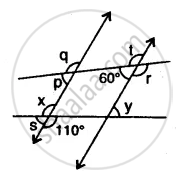
In the given figure, the directed lines are parallel to each other. Find the unknown angles.
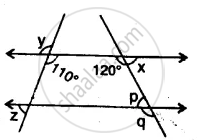
In the given figure, the directed lines are parallel to each other. Find the unknown angles.
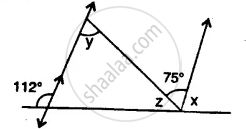
In the given figure, the directed lines are parallel to each other. Find the unknown angles.

In the given figure, the directed lines are parallel to each other. Find the unknown angles.
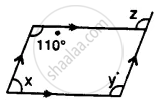
In the given figure, the directed lines are parallel to each other. Find the unknown angles.

In the given figure, the directed lines are parallel to each other. Find the unknown angles.

Find x, y and p is the given figure
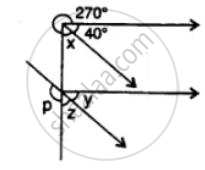
Find x, y and p is the given figure
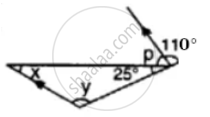
Find x in the following case:

Find x in the following case:
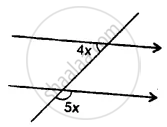
Find x in the following case:
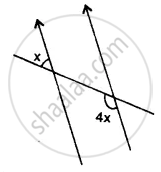
Find x in the following case:
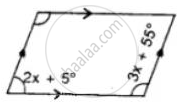
Find x in the following case:
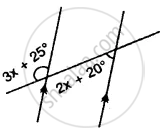
Find x in the following case:
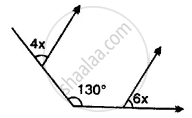
Selina solutions for Concise Mathematics [English] Class 7 ICSE 14 Lines and Angles (Including Construction of angles) Exercise 14 (C)
Using ruler and compasses, construct the following angle:
30°
Using ruler and compasses, construct the following angle:
15°
Using ruler and compasses, construct the following angle:
75°
Using ruler and compasses, construct the following angle:
180°
Using ruler and compasses, construct the following angle:
165°
Using ruler and compasses, construct the following angle:
22.5°
Using ruler and compasses, construct the following angle:
37.5°
Using ruler and compasses, construct the following angle:
67.5°
Draw ∠ABC = 120°. Bisect the angle using ruler and compasses only. Measure each 1 angle so obtained and check whether the angles obtained on bisecting ∠ABC are equal or not.
Draw a line segment PQ = 6 cm. Mark a point A in PQ so that AP = 2 cm. At point A, construct angle QAR = 60°.
Draw a line segment AB = 8 cm. Mark a point P in AB so that AP = 5 cm. At P, construct angle APQ = 30°.
Construct an angle of 75° and then bisect it.
Draw a line segment of length 6.4 cm. Draw its perpendicular bisector.
Draw a line segment AB = 5.8 cm. Mark a point P in AB such that PB = 3.6 cm. At P, draw a perpendicular to AB.
In the case, given below, draw a line through point P and parallel to AB:
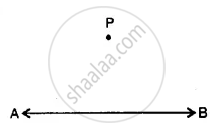
In the case, given below, draw a line through point P and parallel to AB:
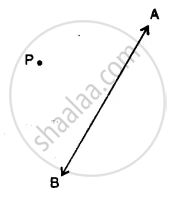
In the case, given below, draw a line through point P and parallel to AB:
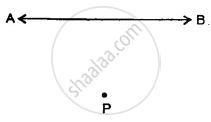
Solutions for 14: Lines and Angles (Including Construction of angles)
![Selina solutions for Concise Mathematics [English] Class 7 ICSE chapter 14 - Lines and Angles (Including Construction of angles) Selina solutions for Concise Mathematics [English] Class 7 ICSE chapter 14 - Lines and Angles (Including Construction of angles) - Shaalaa.com](/images/concise-mathematics-english-class-7-icse_6:880cdcd6265b4864b6486afbf92875b0.jpg)
Selina solutions for Concise Mathematics [English] Class 7 ICSE chapter 14 - Lines and Angles (Including Construction of angles)
Shaalaa.com has the CISCE Mathematics Concise Mathematics [English] Class 7 ICSE CISCE solutions in a manner that help students grasp basic concepts better and faster. The detailed, step-by-step solutions will help you understand the concepts better and clarify any confusion. Selina solutions for Mathematics Concise Mathematics [English] Class 7 ICSE CISCE 14 (Lines and Angles (Including Construction of angles)) include all questions with answers and detailed explanations. This will clear students' doubts about questions and improve their application skills while preparing for board exams.
Further, we at Shaalaa.com provide such solutions so students can prepare for written exams. Selina textbook solutions can be a core help for self-study and provide excellent self-help guidance for students.
Concepts covered in Concise Mathematics [English] Class 7 ICSE chapter 14 Lines and Angles (Including Construction of angles) are Concept for Pairs of Angles, Construction of a Line Parallel to a Given Line from a Point Outside It ., Properties of Parallel Lines, Introduction to Lines and Angles.
Using Selina Concise Mathematics [English] Class 7 ICSE solutions Lines and Angles (Including Construction of angles) exercise by students is an easy way to prepare for the exams, as they involve solutions arranged chapter-wise and also page-wise. The questions involved in Selina Solutions are essential questions that can be asked in the final exam. Maximum CISCE Concise Mathematics [English] Class 7 ICSE students prefer Selina Textbook Solutions to score more in exams.
Get the free view of Chapter 14, Lines and Angles (Including Construction of angles) Concise Mathematics [English] Class 7 ICSE additional questions for Mathematics Concise Mathematics [English] Class 7 ICSE CISCE, and you can use Shaalaa.com to keep it handy for your exam preparation.
